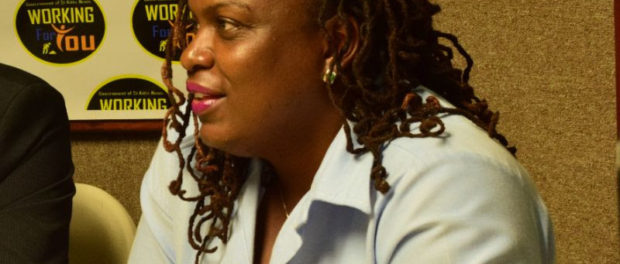PERSONS HAVE THE SAME RIGHT TO PROTECT THEIR INTELLECTUAL PROPERTY JUST AS THEIR PHYSICAL PROPERTY
Get our headlines on WHATSAPP: 1) Save +1 (869) 665-9125 to your contact list. 2) Send a WhatsApp message to that number so we can add you 3) Send your news, photos/videos to times.caribbean@gmail.com

| Basseterre, St. Kitts, June 20, 2019 (SKNIS): Appearing on the radio and television show, “Working for You” on June 19, Jihan Williams, Acting Registrar of the Intellectual Property Office of St. Kitts and Nevis (IPOSKN), said that just like tangible property, persons have a right to protect their intellectual property. Ms. Williams stated that when persons refer to intellectual property it is just as important as a car, phone or a house. She explained the difference between physical property and intellectual property. “The form is different in the sense that it is property that you have created with your mind, with your intellect,” she said. “The same way that I could tell somebody leave my car or leave my house, don’t enter, don’t use it, is the same way that if I create something with my mind it is my intellectual property and it is the same way that I can tell you don’t use my poem, don’t use my song or my invention because that is intellectual property.” Ms. Williams said that there are rights given to the owners of intellectual property that enable them to take certain actions if they notice someone is using their intellectual property in a way that they have not authorized. “The whole study of intellectual property law concerns all the legal principles that are associated with those intellectual property rights,” she said. “Even if you acknowledge someone, the person still has the right to say don’t use it. It is theirs, they get to determine how it is used, when it is used. It is exclusive to them. Someone else who even may have bought it from them, they may not have been given the exclusive rights. They may have just given you the license to use it. You paid to use it, you did not necessarily buy the rights to own it and determine how it could be used.” Ms. Williams gave an example of a photographer’s right to their pictures, noting that the IPOSKN often holds workshops for these photographers to educate them of their rights. “You might go to a photographer to take some pictures. The photographer may give you copies of the pictures. You would think, these are my pictures, but they are not your pictures. They belong to the photographer. He is the one who took it. Even though you hired him, you usually are paying for the service of a photographer, but you have not paid for the ownership of the pictures, she stated. “A lot of people think that because I pay for things, I own it, but it might not be necessarily be the case.” In terms of ownership, Ms. Williams stated that even if the picture is watermarked and someone crops it, it will be up to the owner to prove that they own the picture. “So, it’s a balance of evidence really and then you would have to go to the court, and the person earned $100,000 from my picture and the money should rightfully be mine,” she said. Ms. Williams noted that watermarks are useful, but not necessarily in protecting one’s intellectual property, but rather as alerting users of the ownership of the intellectual property and who they should ask for permission to use it. She stated that the IPOSKN is tasked with raising awareness so that persons understand that there are laws against intellectual property theft. These include copywrite legislation, trade mark, patent, geographical indication and trade secrets. |
Leave a comment
You must be logged in to post a comment.